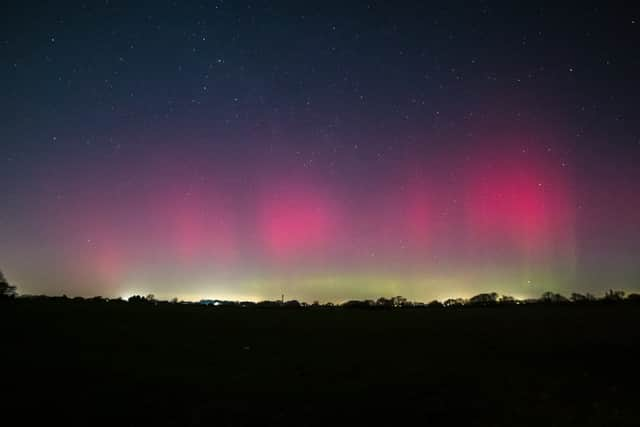What are the Northern Lights? Aurora borealis explained - and why can we see them in the UK tonight
and live on Freeview channel 276
Twenty-four hours after ideal conditions allowed them to illuminate the night sky as far south as Cambridgeshire, the Northern Lights may be visible in the UK for a second consecutive evening - cloud cover permitting.
The natural phenomenon was spotted across the UK on Sunday (26 February) evening, including in the Outer Hebrides, North Wales, Cambridgeshire, and Shropshire. The national weather service tweeted: “A coronal hole high speed stream arrived this evening combined with a rather fast coronal mass ejection leading to #Aurora sightings across the UK.”
Advertisement
Hide AdAdvertisement
Hide AdThe Met Office said the lights may also be visible on Monday (27 February) evening, although cloudy skies may limit those who get a second chance to witness it.
But what exactly are the lights? How are they formed, and are they dangerous to the average observer on the ground? Here is everything you need to know. Here is everything you need to know about it.
What are the Northern Lights?
Auroras - the aurora borealis in the northern hemisphere and the aurora australis in the south - are created by disturbances in the upper atmosphere caused by a flow of particles from the Sun, known as the solar wind.
They are usually concentrated around the Earth’s magnetic poles, and seeing the Aurora Borealis is usually something people travel to the most northern parts of the world to see, like Iceland and Norway.


Advertisement
Hide AdAdvertisement
Hide AdBut the arrival of a coronal mass ejection from the Sun can cause the annulus to expand, bringing the aurora to lower latitudes. It is under these circumstances that the lights can be seen in the UK.
The activity seen in recent days was the result of a coronal mass ejection kicked out by a solar storm, which Mark Gibbs, the head of space weather at the Met Office, said was not unusual for this point in the solar cycle.
“What we saw yesterday was a bubble of magnetised plasma particles that had come off the Sun, and they happened to be heading towards the Earth in this instance,” he said.
The Earth’s magnetic field forms the "magnetosphere," an extended invisible sphere of magnetic energy that surrounds the Earth and is able to deflect most of the solar wind away from the planet.
Advertisement
Hide AdAdvertisement
Hide AdBut at higher latitudes around the polar regions, the shape of the magnetic field means it falls almost vertically to the planet’s surface, and is unable to repel solar wind particles.
These particles are mainly electrons with charge and energy, and take about two days to reach our planet from the Sun - which is why websites like Aurora Watch are able to accurately predict auroras appearing further south than usual.
When they do enter the Earth’s upper atmosphere and interact with the atoms that form it, those atoms become “excited”, giving off heat and light. It is these interactions that we observe as moving lights in the sky.
“The most common [colour to see during an aurora] is green,” says Gibbs, “which is the result of oxygen atoms being excited. Last night we saw some reds and purples, indicative of nitrogen atoms being excited.”
Advertisement
Hide AdAdvertisement
Hide AdThough the aurora borealis is active year-round, and its strength can be increased by solar activity at any time, the chances of seeing the lights vastly increase throughout the autumn and winter months, when the nights are longer and darker.
Are the Northern Lights dangerous?
Though it may appear as if the green bands of the Northern Lights are swirling above our heads no higher than the average rain cloud, they’re actually at altitudes of over 100 km (62 miles).
As such, people observing the aurora borealis from the ground are not in any danger, as it takes place so high in the atmosphere. The lights don’t even pose a threat to people travelling on aircraft - most commercial airliners cruise no higher than an altitude of 42,000 feet (about eight miles).
There are concerns that particularly concentrated solar flares could pose a risk to electronics systems and infrastructure on Earth, as electrical currents generated by the particles can travel to the ground.
Advertisement
Hide AdAdvertisement
Hide AdIn extreme cases, this could have an impact on computer networks and things like oil and gas pipelines and power lines, but reports of the aurora causing any significant disruption to these systems are rare.
Comment Guidelines
National World encourages reader discussion on our stories. User feedback, insights and back-and-forth exchanges add a rich layer of context to reporting. Please review our Community Guidelines before commenting.
